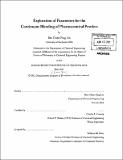| dc.contributor.advisor | Charles L. Cooney. | en_US |
| dc.contributor.author | Lin, Ben Chien Pang | en_US |
| dc.contributor.other | Massachusetts Institute of Technology. Dept. of Chemical Engineering. | en_US |
| dc.date.accessioned | 2011-09-13T17:49:01Z | |
| dc.date.available | 2011-09-13T17:49:01Z | |
| dc.date.copyright | 2011 | en_US |
| dc.date.issued | 2011 | en_US |
| dc.identifier.uri | http://hdl.handle.net/1721.1/65761 | |
| dc.description | Thesis (Ph. D.)--Massachusetts Institute of Technology, Dept. of Chemical Engineering, 2011. | en_US |
| dc.description | Cataloged from PDF version of thesis. | en_US |
| dc.description | Includes bibliographical references (p. 113-119). | en_US |
| dc.description.abstract | The transition from traditional batch blending to continuous blending is an opportunity for the pharmaceutical industry to reduce costs and improve quality control. This operational shift necessitates a deeper understanding of the mixing process informed by particle dynamics and variable interdependencies. The thesis aims to establish a framework for characterizing and improving continuous pharmaceutical blending using a tiered experimental methodology and multivariate analysis. This parameter space exploration attempts to reconcile previous research within the context of cohesive pharmaceutical powders and develop general design principles for maximizing blender performance. A design of experiments was conducted to determine mixing performance with respect to three factors - physical design, operating parameters, and material properties. Multivariate analysis using projections to latent structures was employed to quantify the effect of raw and intermediate variables on the variance reduction ratio. Significant parameters identified included the choice of API, fill fraction, the number of blade passes, the mean residence time, the Bodenstein number, and the period of input feed fluctuations. The results highlight the importance of shear and radial mixing for cohesive powders, which suggest that one-dimensional axial models common in blending literature may not be a sufficient theoretical framework for pharmaceutical applications. The research yielded several insights into design principles for optimizing blending performance. Increasing mean residence time and radial mixing create more robust processing by reducing the impact of material properties and fluctuations in feed consistency. The variance reduction ratio can be improved in a cost-effective manner by determining the fill fraction which maximizes intermediate metrics such as space time, mean residence time, and the number of blade passes. Multivariate analysis was demonstrated to be a practical tool for parameter space optimization and a promising technique for characterizing the effect of material properties on processing. | en_US |
| dc.description.statementofresponsibility | by Ben Chien Pang Lin. | en_US |
| dc.format.extent | 119 p. | en_US |
| dc.language.iso | eng | en_US |
| dc.publisher | Massachusetts Institute of Technology | en_US |
| dc.rights | M.I.T. theses are protected by
copyright. They may be viewed from this source for any purpose, but
reproduction or distribution in any format is prohibited without written
permission. See provided URL for inquiries about permission. | en_US |
| dc.rights.uri | http://dspace.mit.edu/handle/1721.1/7582 | en_US |
| dc.subject | Chemical Engineering. | en_US |
| dc.title | Exploration of parameters for the continuous blending of pharmaceutical powders | en_US |
| dc.type | Thesis | en_US |
| dc.description.degree | Ph.D. | en_US |
| dc.contributor.department | Massachusetts Institute of Technology. Department of Chemical Engineering | |
| dc.identifier.oclc | 749124514 | en_US |
